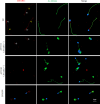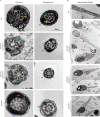Association of novel DNAH11 variants with asthenoteratozoospermia lead to male infertility
- PMID: 39256880
- PMCID: PMC11389119
- DOI: 10.1186/s40246-024-00658-w
Association of novel DNAH11 variants with asthenoteratozoospermia lead to male infertility
Abstract
Background: Bi-allelic variants in DNAH11 have been identified as causative factors in Primary Ciliary Dyskinesia, leading to abnormal respiratory cilia. Nonetheless, the specific impact of these variants on human sperm flagellar and their involvement in male infertility remain largely unknown.
Methods: A collaborative effort involving two Chinese reproductive centers conducted a study with 975 unrelated infertile men. Whole-exome sequencing was employed for variant screening, and Sanger sequencing confirmed the identified variants. Morphological and ultrastructural analyses of sperm were conducted using Scanning Electron Microscopy and Transmission Electron Microscopy. Western Blot Analysis and Immunofluorescence Analysis were utilized to assess protein levels and localization. ICSI was performed to evaluate its efficacy in achieving favorable pregnancy outcomes for individuals with DNAH11 variants.
Results: In this study, we identified seven novel variants in the DNAH11 gene in four asthenoteratozoospermia subjects. These variants led the absence of DNAH11 proteins and ultrastructure defects in sperm flagella, particularly affecting the outer dynein arms (ODAs) and adjacent structures. The levels of ODA protein DNAI2 and axoneme related proteins were down regulated, instead of inner dynein arms (IDA) proteins DNAH1 and DNAH6. Two out of four individuals with DNAH11 variants achieved clinical pregnancies through ICSI. The findings confirm the association between male infertility and bi-allelic deleterious variants in DNAH11, resulting in the aberrant assembly of sperm flagella and contributing to asthenoteratozoospermia. Importantly, ICSI emerges as an effective intervention for overcoming reproductive challenges caused by DNAH11 gene variants.
Keywords: DNAH11; Asthenoteratozoospermia; ICSI; Male infertility; WES.
© 2024. The Author(s).
Conflict of interest statement
The authors declare no competing interests.
Figures





Similar articles
-
Novel variants in DNAH6 cause male infertility associated with multiple morphological abnormalities of the sperm flagella (MMAF) and ICSI outcomes.Asian J Androl. 2024 Jan 1;26(1):91-98. doi: 10.4103/aja202328. Epub 2023 Aug 11. Asian J Androl. 2024. PMID: 37594300 Free PMC article.
-
DNAH3 deficiency causes flagellar inner dynein arm loss and male infertility in humans and mice.Elife. 2024 Nov 6;13:RP96755. doi: 10.7554/eLife.96755. Elife. 2024. PMID: 39503742 Free PMC article.
-
Novel biallelic variants in DNAH1 cause multiple morphological abnormalities of sperm flagella with favorable outcomes of fertility after ICSI in Han Chinese males.Andrology. 2024 Feb;12(2):349-364. doi: 10.1111/andr.13476. Epub 2023 Jun 20. Andrology. 2024. PMID: 37302001
-
Insight on multiple morphological abnormalities of sperm flagella in male infertility: what is new?Asian J Androl. 2020 May-Jun;22(3):236-245. doi: 10.4103/aja.aja_53_19. Asian J Androl. 2020. PMID: 31210147 Free PMC article. Review.
-
A novel variant in CFAP69 causes asthenoteratozoospermia with treatable ART outcomes and a literature review.J Assist Reprod Genet. 2023 Sep;40(9):2175-2184. doi: 10.1007/s10815-023-02873-1. Epub 2023 Jul 1. J Assist Reprod Genet. 2023. PMID: 37392306 Free PMC article. Review.
Cited by
-
Function of manchette and intra-manchette transport in spermatogenesis and male fertility.Cell Commun Signal. 2025 May 29;23(1):250. doi: 10.1186/s12964-025-02213-z. Cell Commun Signal. 2025. PMID: 40442757 Free PMC article. Review.
-
Diagnostic Role of Immunofluorescence Analysis in Primary Ciliary Dyskinesia-Suspected Individuals.J Clin Med. 2025 Mar 13;14(6):1941. doi: 10.3390/jcm14061941. J Clin Med. 2025. PMID: 40142748 Free PMC article.
References
Publication types
MeSH terms
Substances
Grants and funding
- 82101681/National Natural Science Foundation of China
- 82271639/National Natural Science Foundation of China
- 82071705/National Natural Science Foundation of China
- 2023D017/the Science and Technology Project of Fujian Province
- 2022AH030113/University Outstanding Youth Program of Anhui Provincial Education Department
LinkOut - more resources
Full Text Sources
Medical

